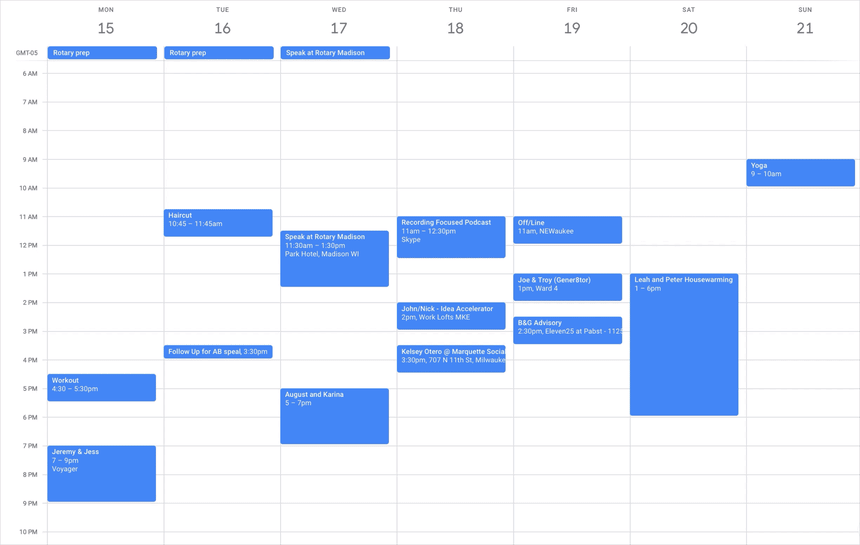Some days we don’t have enough time, other days we have too much. As a result, we either never get around to the things we really want to do, or we procrastinate. That’s why productivity expert John Zeratsky’s calendar is always full, no matter what his workload.
From the time he wakes up until he goes to bed, Zeratsky’s entire day is scheduled, including meals, writing, breaks, meetings, checking email, and exercise. Zeratsky, who lives in Milwaukee, Wisconsin, even schedules time specifically to spend with his wife.
“I like to think about not just the work I’m going to do during the work day, but I like to think about all the elements of my day,” Zeratsky tells NBC News BETTER. “When am I going to take a break? When am I going to have lunch? What am I going to do later in the day to re-energize? A lot of it is honestly because I don’t always make the best decisions when I leave that to the moment.”
More from NBC News BETTER:
9 things to do this morning to make your day more productive
The productivity hack that helped me do more in less time
12 tips to master your kids’ morning routine
Zeratsky says he developed the method when he worked at Google Ventures, and wrote about it in his most recent book “Make Time: How to Focus on What Matters Every Day,” which he co-authored with his colleague Jake Knapp.
“Instead of optimistically hoping that I would get around to the things that I wanted to do, I realized I had to actually schedule it in,” Zeratsky says.
Zeratsky first began using the method while writing his first book, “Sprint: How to Solve Big Problems and Test Ideas in Just Five Days,” back in 2014, which he also co-authored with Knapp.
Here’s how Zeratsky fits what he calls “all the elements of a good day,” or everything he wants to prioritize on a daily basis, into his calendar.
The ‘calendar overlay’ method
Zeratsky creates a daily template for his week in Google Calendar that contains all his elements for a good day, which he calls his calendar “overlay.”
He toggles the overlay on and off his regular calendar and makes adjustments as needed.
For Zeratsky, writing comes easiest in the mornings, so he schedules his writing projects into his calendar overlay for the mornings and schedules meetings and administrative tasks for the afternoon.
When he opens his calendar in the morning, he can customize his overlay to fit with his regular calendar.
For example, if he has a doctor’s appointment in the morning, he can adjust his calendar overlay around it.
“What if I went from working on my writing in the morning to working on that in the afternoon? I can play around with making those adjustments in that template without messing up my actual real calendar,” he says.
To avoid procrastination, he’ll often schedule two events at the same time into his overlay.
“For the afternoon, I’ll have one big block that says ‘admin work – catch up on email,’ and then I’ll have a couple of meeting slots, that way maybe some days I don’t have any meetings scheduled in the afternoon, or maybe I have a meeting scheduled but another block is free. Then when that meeting block isn’t being used, I can fall back on what else am I supposed to be doing with this part of my day,” Zeratsky explains.

(Calendar Illustration by John Zeratsky)
The ‘full bonsai’ calendar method
For those who need more structure, Zeratsky recommends “the full bonsai” calendar method, which he compares to “trimming a bonsai tree.”
Instead of having a separate template that overlays your regular calendar, you’re going to build all the elements of a good day directly into your regular calendar. Your calendar will be less flexible, he says, but it will force you to be more mindful about how you schedule your time.
Start small
Adjusting to these methods may take some getting used to if you have a packed, busy schedule, Zeratsky says. He recommends taking baby steps. Start by finding a small part of your day you can exercise some control over, he says.
“Find one small thing you can do, make the change, try it out for a couple of days or a week and see how it goes,” says Zeratsky.
A more balanced day
Zeratsky says calendar overlays have allowed him to bring his “full energy and attention to the things that I am doing.”
“Every day feels really good, it feels really well balanced between focused creative work, administrative work, breaks, meals, any kind of social stuff, movement or exercise, and it feels like something I can do day after day, indefinitely,” he says.
Julie Compton is a freelance journalist in Brooklyn, New York. Follow her @julieallmighty.
The article “Want to Get More Done? Use This Calendar Technique to Schedule a Better Day” originally published on NBC News BETTER.




